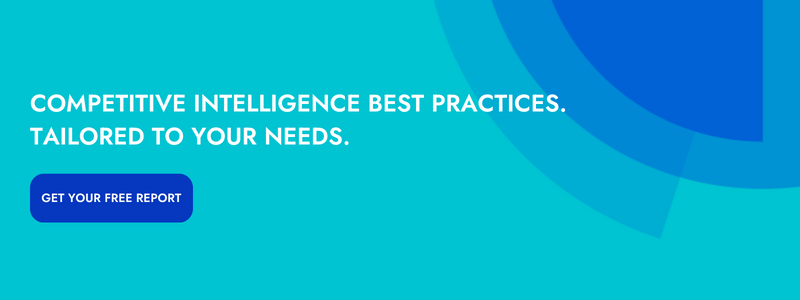Competitive Intelligence (CI) is a function that fits into every business strategy. No matter what your product or service is, you’ve got competitors fighting to win the same business as you and crafting strategies to stand out from the rest of your market. The benefits of competitive intelligence extend across your whole organization, so it’s hard to pinpoint just one simple benefit. The truth is that competitive intelligence will benefit your sales, marketing, product, product marketing, customer success, and executive team. Let’s dig into some key actionable outcomes of competitive intelligence.
Actions for Your Sales Enablement Strategy
When you conduct competitive intelligence research, you’re seeking to find information about your competitors’ products, services, pricing, and more. These insights will help your whole business, but especially your sales team. When you gather competitive intelligence information, you can turn those insights into actionable takeaways that your sales team can leverage in competitive situations.
With competitive intelligence insights, you can provide your sales team with many pieces of collateral and additional training materials. Your sales team wants timely, actionable, and impactful pieces of collateral that will support them in a competitive deal, especially when it comes to handling objections. If your sales team is able to leverage competitive sales enablement materials, you’ll see an increase in your competitive win rate, and ultimately, you’ll see an increase in revenue.
- Provide competitive battlecards that your sales team can reference while on a phone call with a prospect. An effective battlecard has a combination of strategic and tactical information. Get started with the basics about a company, then add in more content such as win/loss stories, landmines, pricing, and current events.
- Build competitive one-pagers for easy to digest highlights of how your product or service compares to a competitor. Build this with quick statements about what your product is / is not, as well as what your competitor’s product is / is not. You can even induce quotes from customers that show the power of your product over that of your competitor. While battlecards provide excellent lifelines that salespeople can tap any time, even during a call, one-pagers should dive deeper and serve as competitive enablement foundations across your go-to-market organization.
- Create sound bites to have cohesive and on-brand messaging for tackling common competitive objections. When you hear something come up time and time again, it’s a great idea to come up with common responses for your sales reps. That way, they have a strong answer, with data to back up the claim. Include these sound bites on your competitive battlecards and your competitive one-pagers for easy access.
- Draft email templates for stronger competitive outreach. If your sales team is reaching out to prospects, you want them to send emails that will resonate. Rather than your sales reps sending emails that directly tear down a competitor, provide your sales team with emails that highlight the power of your own product, in a way that captures the prospect’s attention.
Actions for Your Marketing Strategy
There are many elements of success in a marketing strategy. You have your content strategy, social media strategy, demand generation/growth strategy, and last but definitely not least, your product marketing strategy. All of these marketing initiatives can be enhanced with competitive intelligence information.
- Fill in the gaps by analyzing your competitors’ content strategies, SEO strategies, and the quality of the content. You can fill in the gaps of the market with your content to better address the needs of your target audience. Plus, depending on their Google rankings, you can target new keywords.
- Improve your social media reach by looking at their social media posts, engagement, and monitoring which platforms your competitors are on. That way, you can gain insight into how social media plays into their overall strategy. Maybe they’re only on one specific channel, but neglecting another - that’s an opportunity for you to leverage that channel and expand your reach.
- Inspire your own campaigns from your competitors’ campaigns. Pay attention to their landing pages, paid social media, ad copy, and A/B tests. Not only can you track their marketing investments, but you can use their campaigns to craft your own.
- Craft differentiated messaging to ensure that you stand out in your market. Based on your competitive and market research, you can identify common themes and weave that into your messaging to better resonate with your target audience.
Actions for Your Product Strategy
The best way to improve your product or service is by listening to your audience. Whether you’re listening to your own customers through market research and customer interviews, or you’re reviewing third-party websites, you can find a lot of information about customer pain points. Additionally, you need to search your competitors’ reviews on third-party sites. When people are reviewing something online, they’re brutally honest, so you’ll be able to gain insight into the good and the bad of your competitors’ products.
- Shape your product roadmap with findings from third-party review sites into your product roadmap. You’ll be able to gather information about what your competitors have that you don’t, or what your customers wish your product had. Analyze how you stack up to your competitors’ products and integrate your findings into your product roadmap.
- Redesign your pricing and packaging based on how you stack up against your competition. If your competitors are winning more business due to certain elements within their pricing and packaging structures, adjust yours to be more competitive.
Actions for Your Overall Business Strategy
Some additional actionable outcomes of competitive intelligence benefit your organization as a whole.
- Prevent customers from churning by keeping a pulse on your competitors. Customers often churn when they believe they’ve found a “better” solution. However, if you track the messaging your competitors are releasing as well as having a full understanding of what their products truly offer, your CS teams will be able to address concerns early, and retain customers.
- Stay on top of your competitive landscape. Conducting competitive intelligence research will allow you to understand your complete competitive landscape - direct, indirect, aspirational, and even emerging competitors. You’ll want to know who you might be competing for business.
Gathering and analyzing your competitive intelligence data is important, but the real value comes from turning those insights into action. If you don’t turn your insights into action, your competitive intelligence strategy won’t benefit your business. These are just some of the key actionable outcomes of a successful competitive intelligence strategy. To learn more about competitive intelligence, download our new Guide to Competitive Intelligence.

Related Blog Posts
Popular Posts
-
 How to Create a Competitive Matrix (Step-by-Step Guide With Examples + Free Templates)
How to Create a Competitive Matrix (Step-by-Step Guide With Examples + Free Templates)
-
 The 8 Free Market Research Tools and Resources You Need to Know
The 8 Free Market Research Tools and Resources You Need to Know
-
 Sales Battlecards 101: How to Help Your Sellers Leave the Competition In the Dust
Sales Battlecards 101: How to Help Your Sellers Leave the Competition In the Dust
-
 6 Competitive Advantage Examples From the Real World
6 Competitive Advantage Examples From the Real World
-
 How to Measure Product Launch Success: 12 KPIs You Should Be Tracking
How to Measure Product Launch Success: 12 KPIs You Should Be Tracking





